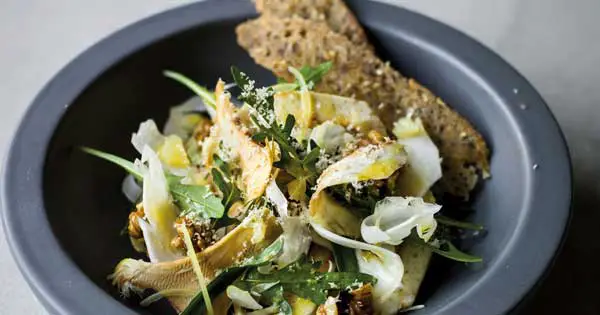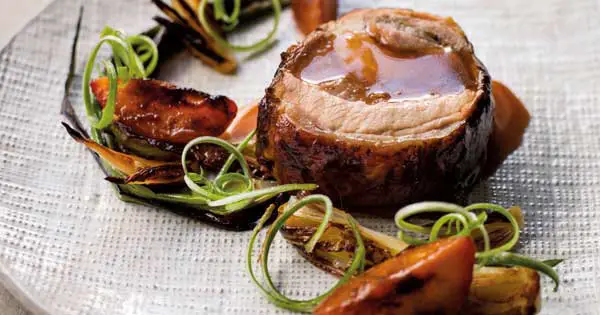“I think it’ll be safer for you – and me – if we use a peeler,” says Monica Galetti, as my hands fumble between a baby artichoke and a serrated knife.
Formerly Michel Roux Jr.’s senior sous-chef at the two-Michelin starred Le Gavroche in London, Galetti is best known as a presenter on MasterChef: The Professionals.

She’s made a name for herself on the show for turning so-called ‘pro’ chefs into quivering wrecks, often standing over them – eyebrows contorted in horror – as they fail spectacularly at simple skills tests, their years of training turning to mush as they burn honeycomb, massacre sea urchins and forget to wipe down their work station.
The woman is formidable, her disappointment something you hope to never experience.
So when she takes a knife off you, out of fear for her life and your thumbs (I exaggerate, I hope…), you can’t help but feel a little downcast.
Well, until she returns from fetching the peeler, a huge grin on her face, because, while Galetti is undoubtedly awe-inspiring and thoroughly impressive, she’s not half as intimidating as those crafty MasterChef editors make her out to be.
“Lots of people in industry kitchens use peelers,” she tells me kindly.
In fact, the best word to describe the Samoan-born chef, who grew up in New Zealand, is lovely – and all those aghast faces she pulls on camera? That’s just exasperation at seeing quality produce wasted.
We’re making an artichoke salad with preserved lemon and pickled walnuts from her new book, aptly named The Skills, in which she explains step-by-step – with accompanying photos of each stage – how to behave like an expert chef in the kitchen, from filleting fish and boning pork belly, to making Italian meringue and preparing squid.
Between her TV persona and cookbooks, you’d think Galetti would be a born teacher, but she admits it’s “taken work, I’ve had to slow myself down”. By slowing herself down, she means making sure she remembers not make the whole dish without thinking, while trying to explain it to a hapless student – in this case, me.
Recalling how she used to prep crates of around 60 artichokes every morning when she started out in the restaurant business, today, Galetti manages to do one on autopilot (“Sorry, I didn’t say what I was doing at all”), before doing another in the same way (“I’ve done it again!”).
As we slice figs and blend ground almonds with butter and sugar for a frangipane tart, she tells me she’s been cooking since she was tiny.
“Literally, when my ma found out I was a girl, she knew it – she had it made,” Galetti says with a laugh.
“In our culture, the girls learn to cook really early on, it’s your role, and you don’t think anything of it because it’s so natural for us,” she adds, explaining how food and being together is the heart of family life. “When people visit, it’s really rude not to offer them something to eat, even if it’s a cup of tea and piece of cake – you always have to give them something.”
That’s not to say her parents weren’t surprised when she turned cooking into a full-time career.
“My dad was really disappointed,” Galetti remembers. “He was like, ‘What? You want to cook – for other people?!’ Going to cook for someone else was seen as ‘Woah!’ He didn’t get it.”
His pride in his daughter is a given now though, and with Galetti – who has one daughter of her own with her husband, French-born sommelier David – set to open her own London restaurant, Mere, in January, it’s only set to grow.
We eat a sticky, sugar sprinkled fig ‘tarte fine’ between us, but then realise we made too much frangipane, so Galetti wraps it up in a Tupperware and cling film and gets me to promise to take it home and make more tarte.
Told you she was lovely.
Reckon you’ve got the skills? Try one of these three recipes from Monica Galetti’s new book…

Artichoke salad with lemon and fennel
(Serves 4)
4 globe artichokes
Olive oil, for cooking
1 garlic clove, peeled
1 small baguette, very thinly sliced
1 large fennel bulb, with fronds reserved
10g baby spinach
10g rocket or dandelion leaves
1tbsp chive batons
1tbsp flat-leaf parsley leaves
1tbsp tarragon leaves
10 pickled walnuts, roughly chopped
1 small preserved lemon, seeds removed, skin finely sliced and flesh roughly chopped
2 walnuts, to garnish
Sea salt and freshly ground black pepper
For the dressing:
100ml walnut oil
1tsp Dijon mustard
2tbsp white balsamic vinegar
Peel and prepare the artichokes and set aside in a bowl of acidulated water (water with a little vinegar or lemon juice in it, to stop the artichoke from going brown).
Heat a little olive oil with the garlic clove in a frying pan and cook the baguette slices on both sides until golden, then drain on kitchen paper.
Thinly slice the fennel and place in a bowl of iced water. Thinly slice the prepared artichoke into a large bowl. Drain the fennel and add to the artichoke.
Gently mix in the baby spinach, rocket or dandelion, and the herbs. Add the pickled walnuts, preserved lemon and fennel fronds to the salad. Season with salt and pepper.
For the dressing, whisk the walnut oil, mustard and vinegar together and use to dress the salad. Finely grate the walnuts for garnish and sprinkle over the salad. Add the crisp baguette slices.

Rolled pork belly with black apple butter
(Serves 5-6)
1kg pork belly, ribs removed
3 thyme sprigs, leaves only
1 rosemary sprig, leaves chopped
Olive oil, for cooking
1 small onion, roughly chopped
1 carrot, roughly chopped
2 celery stalks, roughly chopped
3L chicken stock
3 fresh or dried bay leaves
3 rosemary sprigs
5 thyme sprigs
1tsp peppercorns
2tbsp butter
Sea salt and freshly ground black pepper
Seasonal vegetables, to serve
For the Black Apple Butter:
500g Granny Smith apples, peeled, cored and chopped into small pieces
150ml cider
100g black treacle
50g demerara sugar
2tsp mixed spice
Juice of 1 lemon
For the Black Apple Butter, place all the ingredients in a large pan and stew gently until the apples are completely broken down. When most of the liquid has evaporated, transfer to a blender and blitz. Cool and store in the fridge.
Preheat the oven to 140C/275F/Gas 1. Remove two-thirds of the pork skin. Season the inner side of the belly well with one teaspoon of salt and some pepper, and sprinkle the thyme and rosemary over the pork. Roll up the belly, skin-side out. Tie tightly at intervals with butcher’s string.
Heat a little olive oil in a deep braising pan and add the pork to colour on all sides. Remove from the pan, add the onion, carrot and celery to the pan and colour.
Add back the pork with the stock, herbs, one tablespoon of salt and the peppercorns. Bring to a gentle simmer, then transfer to the oven, cover and cook until tender, about two and a half to three hours.
Leave to cool in the cooking liquid, then remove the pork to drain on a wire rack and take off the string. Roll tightly in cling film into a firm cylinder and leave to cool in the fridge, ideally overnight. Strain the cooking liquor into a pan and reduce to a thick sauce consistency.
When ready to eat, cut the set pork into slices and gently pan-fry in olive oil until golden, adding some black apple butter to coat all over just at the end of cooking. Heat some of the reduced sauce, add the butter and whisk through.
Serve the pork with the reduced sauce, with a selection of seasonal vegetables.

Fig ‘tarte fine’
(Serves 6)
325g rough puff pastry
12 ripe figs
50g butter, melted
30g demerara sugar
Sprinkling of icing sugar
For the frangipane:
100g butter, softened
100g caster sugar
130g ground almonds
2 medium eggs
Ice cream and honey, to serve
Preheat the oven to 190C/375F/Gas 5.
Make the frangipane by beating together the butter and sugar until creamy and pale. Add the eggs one at a time and beat in. Add the ground almonds to the mix and beat together. Chill in the fridge until ready to use.
Roll the pastry out to a rectangle about 3mm thick (setting a small piece of pastry to one side) and put on a baking tray lined with baking parchment. Prick the pastry at intervals using a fork. Pipe a thin layer of Frangipane over the pastry, leaving a 2cm border around the edge. Put the reserved piece of pastry on a separate, lined baking tray.
Cut the figs vertically into thick slices and arrange in neat overlapping layers to cover the pastry, then fold in the edges of the pastry. Brush all over with the melted butter and sprinkle with the sugar, then bake both trays in the oven for 20-25 minutes, until cooked.
Take the baked little piece of pastry and crumble finely into a pan with a sprinkling of icing sugar. Cook, stirring, until the sugar has caramelised on the pieces of pastry. Serve the tart warm, sprinkled with the caramelised pastry crumbs, ice cream and honey.
